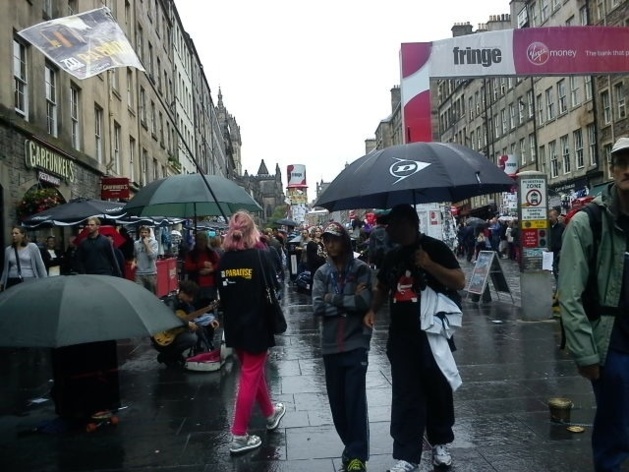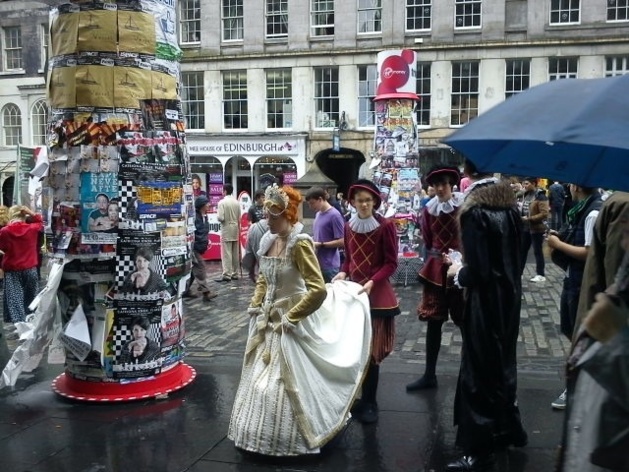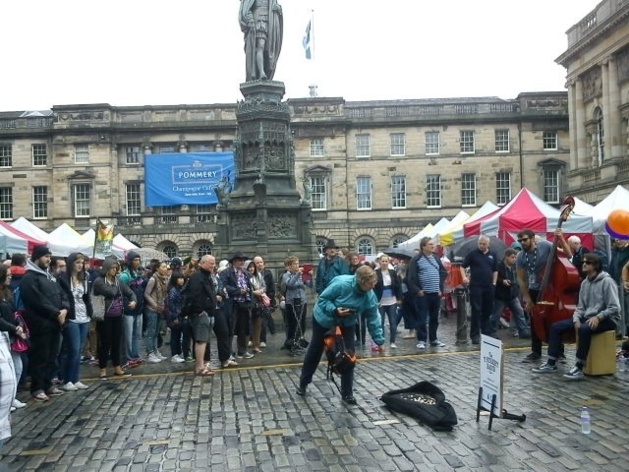
The Royal Mile in stereotypical Scottish weather | Credits : Katrin Heilmann/Le Journal International
Withstanding the Scottish weather (fizzy rain and unpredictability of the weather), tourists walk along the famous Royal Mile in swarms, watching street artists perform trying to avoid the clouts of flyerers (most of them local students) that try to gain their attention for the latest Fringe performance. In their attempts to beat the numerous concurrence production companies come up with extravagant costumes ranging from 19c-clothing to coffin bearers.
With 2871 different shows taking place in venues spread across the city, the Fringe visitor is faced with the impossible situation of having to choose between too many things. For example, on a weekday evening, you get the choice between over 200 different shows ranging from ‘Playing Politics’ - musical Satire; ‘As you like it’ for Shakespeare fans; ‘Blueflint’ – contemporary folk music; ‘Bulletproof Jest’ comedy to ‘Choral Celebration’ by the Choir of Edinburgh’s famous St. Giles Cathedral.
With 2871 different shows taking place in venues spread across the city, the Fringe visitor is faced with the impossible situation of having to choose between too many things. For example, on a weekday evening, you get the choice between over 200 different shows ranging from ‘Playing Politics’ - musical Satire; ‘As you like it’ for Shakespeare fans; ‘Blueflint’ – contemporary folk music; ‘Bulletproof Jest’ comedy to ‘Choral Celebration’ by the Choir of Edinburgh’s famous St. Giles Cathedral.
A case of hating or loving
Residents of Edinburgh often take a ‘hate or love’ attitude towards the festival leading to many summer vacations being purposely taken in August to escape the constant noise of fireworks, the flocks of tourists and the permanent presence of flyerers in the city centre. On the other hand if you enjoy the buzzing atmosphere all over the city with the many shows, exhibitions and events happening – Edinburgh might very well be the place to be in August. The Fringe runs parallel to the International Book Festival, the International Festival, the Royal Military Tattoo and the Edinburgh Art Festival – earning Edinburgh the reputation of Festival capital.

The Fringe 1947 to Today
In 1947 two today world famous art festivals where founded – one of them by Jean Vilar in Avignon, the other one by eight theatre groups coming to Edinburgh, the capital of Scotland. In both places artists tried to reinvigorate European cultural life in the wake of the Second World War. In the case of Edinburgh, the theatre groups came to the Edinburgh International Festival, without having received any invitation, yet they persisted year after year and the Festival has grown to be one of the largest in the world. In contrast to the Festival in Avignon, the Fringe evolved spontaneously without central organisation until 1958 and claims not to vet its programme, which is one of the most renowned guides to the festival.
The Fringe only had central structures created in 1958 with the foundation of the Festival Fringe Society. The society continues to this day to facilitate access for artists by acting as a source of information, while also providing a central organisational structure with its box offices spread across the town. Its annually published Fringe programme is one of the best sources for what is on during the Fringe. The Society prides itself on the fact that it does not vet its programme offering everyone willing to pay to be part of the programme a slot.1 Yet, whether the Fringe is as independent as it used to be is contestable. The high prices for artists to hire venues, be part of the Fringe programme (around £295 for a run of shows, roughly £80 for a single performance) and promote their performance makes it harder for newcomers to start off, while the soaring ticket prices with as much as £15 for a one hour performance make it also less accessible to visitors.
The Fringe only had central structures created in 1958 with the foundation of the Festival Fringe Society. The society continues to this day to facilitate access for artists by acting as a source of information, while also providing a central organisational structure with its box offices spread across the town. Its annually published Fringe programme is one of the best sources for what is on during the Fringe. The Society prides itself on the fact that it does not vet its programme offering everyone willing to pay to be part of the programme a slot.1 Yet, whether the Fringe is as independent as it used to be is contestable. The high prices for artists to hire venues, be part of the Fringe programme (around £295 for a run of shows, roughly £80 for a single performance) and promote their performance makes it harder for newcomers to start off, while the soaring ticket prices with as much as £15 for a one hour performance make it also less accessible to visitors.
The Free Fringe

One of the initiatives to counter the trend that visitors go and see fewer shows in comparison to the past years, is the Free Fringe2, whose concept to ‘bring art back to the people’ has been rather popular in more recent years.
The Free Fringe keeps its promise of being free of charge– though donations are encouraged. It all started off in 1996 with Peter Buckley Hill, a musical comedian, organising a performance without charging for it –as much to the annoyance of a of some promoters as lots of people attended. The Free Fringe has grown over the years and offers today greater diversity. Besides the obligatory comedy acts, there is also programme for children, music, theatre and magic performances as well as talks on topics such as ‘how not to save the planet’; ‘Interview with a Vampire expert’ or ‘how secularism is our right: freedom is our culture’. Other than the Free Fringe, there are also many free street acts to see on the royal mile.
Besides the obligatory unicycle riders you also get balloon artists, jugglers and pantomimes as well as street musicians and stand up comedians. While their acts are necessarily shorter than an ordinary Fringe performance, they greatly contribute to the perception of the Fringe as a vivid celebration of the arts – which tries not to exclude but to invite to discover.
The Free Fringe keeps its promise of being free of charge– though donations are encouraged. It all started off in 1996 with Peter Buckley Hill, a musical comedian, organising a performance without charging for it –as much to the annoyance of a of some promoters as lots of people attended. The Free Fringe has grown over the years and offers today greater diversity. Besides the obligatory comedy acts, there is also programme for children, music, theatre and magic performances as well as talks on topics such as ‘how not to save the planet’; ‘Interview with a Vampire expert’ or ‘how secularism is our right: freedom is our culture’. Other than the Free Fringe, there are also many free street acts to see on the royal mile.
Besides the obligatory unicycle riders you also get balloon artists, jugglers and pantomimes as well as street musicians and stand up comedians. While their acts are necessarily shorter than an ordinary Fringe performance, they greatly contribute to the perception of the Fringe as a vivid celebration of the arts – which tries not to exclude but to invite to discover.



























